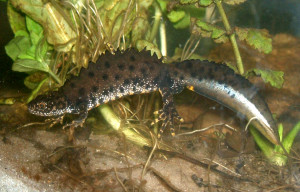Crested newt
 Crested newts are bigger than common newts, up to 18 cm long (commonly 14-15 cm). Their coloration is also darker – it is brown-black or black on top, and its belly is black-spotted orange. Their skin is warty. The crests in breeding males – in contrast to the ones in common newts – are jagged, stopping at the tail base. Males in nuptial dress display a bluish white stripe on the sides of their tails. Females lack a crest, but often have a thin yellow stripe along their backs. It is an extremely rare species in the region of the Pskov-PeipsiLake. It spends the spring and early summer in water, migrating to the land starting mid-June. The crested newt prefers smallish forest lakes, bayous, ponds, ditches, sedge and peat bogs, and runnels. Having left water, and during the day, crested newts hide in rotten stumps, under the bark of fallen trees, in pits with sand and foliage, in rodent holes, or underground mole tunnels. When in water, they are active both day and night, whereas they are exclusively nocturnal ashore. In water the species feeds on water bugs (water-tigers, whirligig beetles, and water scavenger beetles). Mollusks, and pea crabs in particular, are also of great nutritional importance. Quite often these newts also prey on wrigglers, swimming bugs, dragonfly larvae, roe of amphibians and fish, smaller crustaceans, and tadpoles. Foraging ashore is not frequent. The prey aground includes earthworms (up to 65%), slugs (12-22%), insects and their larvae (20-60%), and sometimes younger newts of other species freshly coming ashore. Crested newts hibernate quite late – in October, when air temperature drops to 6-4° centigrade and below freezing at nights. Quite often, active crested newts can be spotted even in early November. This is the most cold-resistant European amphibian, retaining mobility even at 0° Celsius. They winter in environs similar to those of common newts: under thick layers of moss, in rotten stumps, root burrows, rodent and mole holes, sand pits, basements and cellars. Sometimes, dozens of animals gather in colonies, but more often they winter in small groups. The crested newt has few natural enemies due to its highly poisonous skin mucus. Rarely, it does fall prey to water snakes, storks and herons. It can live up to 10-12 years in captivity.
Crested newts are bigger than common newts, up to 18 cm long (commonly 14-15 cm). Their coloration is also darker – it is brown-black or black on top, and its belly is black-spotted orange. Their skin is warty. The crests in breeding males – in contrast to the ones in common newts – are jagged, stopping at the tail base. Males in nuptial dress display a bluish white stripe on the sides of their tails. Females lack a crest, but often have a thin yellow stripe along their backs. It is an extremely rare species in the region of the Pskov-PeipsiLake. It spends the spring and early summer in water, migrating to the land starting mid-June. The crested newt prefers smallish forest lakes, bayous, ponds, ditches, sedge and peat bogs, and runnels. Having left water, and during the day, crested newts hide in rotten stumps, under the bark of fallen trees, in pits with sand and foliage, in rodent holes, or underground mole tunnels. When in water, they are active both day and night, whereas they are exclusively nocturnal ashore. In water the species feeds on water bugs (water-tigers, whirligig beetles, and water scavenger beetles). Mollusks, and pea crabs in particular, are also of great nutritional importance. Quite often these newts also prey on wrigglers, swimming bugs, dragonfly larvae, roe of amphibians and fish, smaller crustaceans, and tadpoles. Foraging ashore is not frequent. The prey aground includes earthworms (up to 65%), slugs (12-22%), insects and their larvae (20-60%), and sometimes younger newts of other species freshly coming ashore. Crested newts hibernate quite late – in October, when air temperature drops to 6-4° centigrade and below freezing at nights. Quite often, active crested newts can be spotted even in early November. This is the most cold-resistant European amphibian, retaining mobility even at 0° Celsius. They winter in environs similar to those of common newts: under thick layers of moss, in rotten stumps, root burrows, rodent and mole holes, sand pits, basements and cellars. Sometimes, dozens of animals gather in colonies, but more often they winter in small groups. The crested newt has few natural enemies due to its highly poisonous skin mucus. Rarely, it does fall prey to water snakes, storks and herons. It can live up to 10-12 years in captivity.
The crested newt is listed in the International Red Book.
/ * The photos at lake.peipsi.org are cross-posted from commons.wikimedia.org and are used for familiarization purposes only. No commercial use of the photos is allowed. For more information about to use the photos see the originals on commons.wikimedia.org. /


